The potentially dangerous, recently discovered, Near Earth Asteroid, 2013 QR1 taken by me on August 25, 2013 at 3:52 through 4:26 UT in one minute frames. This was one day before closest approach. I was under a thunderstorm when it was closest in dark skies. The asteroid was estimated at 250 meters across and was moving about 1.57 minutes of arc per minute of time. The telescope was tracking on the orbital motion of the asteroid causing the stars to appear to move by the asteroid. North is up, west to the right.
We are the target in a shooting gallery with small asteroids the bullets. Earlier this month it was a well known near-Earth asteroid 2003 DZ15, about 150 meters in diameter that came by at about 2.2 million miles when I caught it. It is 250 meters wide (bringing out the big guns?) 2013 QR1 (discovered August 16 UT) caught at about 2.3 million miles though it came within 1.8 million miles the next day. It was nearly as distant that next night as the first night but we had a raging thunderstorm and it was too low in the southwest in any case. While slightly further away it was moving faster than 2003 DZ15. Fortunately, its larger size made it brighter allowing me to use one minute exposures rather than 2 so the star trails aren't as long as they could have been. The animation uses 30 of the 80 frames I took that night. Earlier ones were hurt by poor seeing, later ones by the moon. The frames used were taken on August 25, 2013 starting at 3:52 UT and ending at 4:26 UT. The extra 4 minutes are due to the time needed to download each frame to the computer. While I took 10 frames after this clouds got thicker, the moon brighter and I just couldn't compensate after that. Even so, the asteroid will vary somewhat in brightness due to the various thickness of the clouds I was working through. Later they went away but the moon was so bright I just couldn't pull the asteroid through the moonlight. Due to the poor conditions, I didn't get a magnitude estimate. It was likely about 16.1 or a bit fainter but don't quote me on that!
When I started the imaging run of the 80 frames the asteroid was moving at 1.47 minutes of arc per minute of time. That is the rate the computer used to compensate for the asteroid's motion and was correct. By the end of the 30 frames used it was moving at 1.58 minutes of arc per minute of time. Like a dummy, I didn't reset this rate so the asteroid does drift a bit during the 30 minutes.
North is at the top and west to the right. For some reason, I rotated the 2003 DZ15 image so it appears to move the opposite direction. Both were moving to the west. The earlier one was moving north while this one was moving south. Image scale is about 1.5" per pixel. I say about as the movie maker changed the scale somewhat and I didn't try to determine what the difference was. 2003 DZ15 was at 3" per pixel. Related Designations for 2013QR12013QR1, | Video: https://images.mantrapskies.com//catalog/OTHER/2013QR1/2013QR1.WMV | Near earth asteroid, 20114 CU13 passed by us March 11 about 5 hours UT. Since it was forecast (and really was) cloudy at that time I tried for it just before dawn the night before, March 10. There were some clouds but they soon cleared. I was able to get 30 minutes of data before dawn started to brighten the sky. First few frames were dimmed a bit by the clouds but otherwise, it worked well. The asteroid was about 1.2 million miles from us at the time of the movie and about 1.1 million miles at closest approach the following night so the difference is rather small. We had three other asteroids pass by, one only 38,000 miles out the last few days but all were either clouded out or too far south or lost in the sun from my view.
2014 CU14 was discovered exactly one month ago, February 11, 2014. It is quite large so it is good it kept its distance. Estimates put it at about 200 meters in diameter.
The movie consists of 30 one minute frames and covers about 32 minutes of time as it takes a few seconds to download each frame. The frames were taken at 1.5" per pixel then downsized to 3" per pixel to reduce the size of the animation but keep the full frame. Due to the bright moon not far away the image is rather noisy which greatly enlarged the file. During the imaging run, the mount was tracking on the asteroid rather than the stars. No alignment of the frames was needed. While its motion was calculated from orbital data a couple days prior to the night the earth hadn't perturbed the orbit to any great extent so the values I used to offset from the sidereal rate were sufficient to keep the asteroid near the center of the frame. Computers and today's robotic mounts make such feats rather easy to accomplish. Not long ago even the pros had a hard time doing this type of tracking. The asteroid moved about 1 minute of arc per minute of time. So the star trails pretty well define 1 minute of arc.
14" LX200R @ f/10, 30x1' binned 3x3, STL-11000XM, Paramount ME Related Designations for 2014CU132014CU13, | Video: https://images.mantrapskies.com//catalog/OTHER/2014CU13/2014CU13-3.wmv 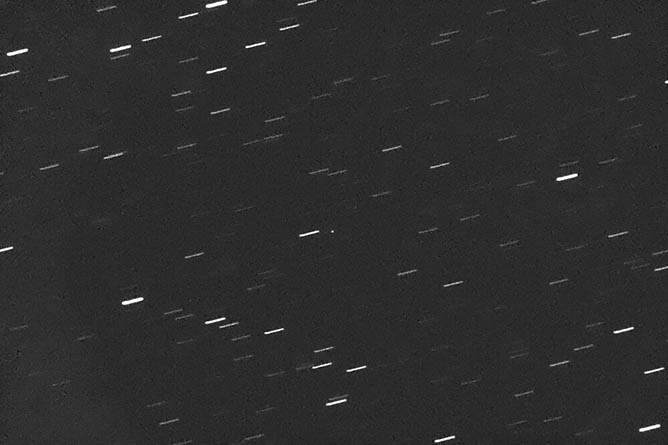
2014CU13-3a.jpg
| On June 3, 2014 a small asteroid, 2014 KH39, passed by at only about 10% further than the moon. It was discovered only days earlier on May 24. Guess this was my birthday present rather than the dud of a meteor storm that was possible that night. It's size is estimated at about 22 meters (72 feet for the metrically challenged). That makes it only slightly larger than the rock that lit up the sky and shattered windows last year in Chelyabinsk Russia. So catching such a small object at that distance was a challenge I had to take up. I quickly discovered it was totally invisible on a frame running at sidereal rate (tracking the stars). It was moving at 2" of arc per second of time when I imaged it about 12 hours before closest approach (closest was in the day with it below my horizon). That speed and its extreme faintness meant it only sent a couple photons to each cell of my detector, not enough to pull it out of the noise. I had to track on the asteroid's orbital motion and trust the mount to know how to do that.
Unfortunately this was the day I did my annual spring cleaning of the telescope system. It was completely disassembled, optics cleaned, gears degreased then regreased, desiccant for the CCD chamber recharged and the friction ring for the filter wheel changed as the old one after 10 years of hard use had died. When all it put back together some pointing accuracy is lost. For accurate tracking without guiding I need to redo the Tpoint map. Even with automation that is a several hour job as I take 800 points. It had been cloudy all day so I didn't expect it to suddenly clear somewhat. It was obvious the "clearing" was temporary and I had to work fast. I found that this time the scope was much closer to proper alignment than ever before when I did this. With no time for a new Tpoint map I hoped the old one would do. Also after regreasing of the drive gear, until that grease is fully worked in the periodic error would be erratic as the grease found its home position. I'd exercised the mount from stop to stop on both axes some 50 times but even that is never quite enough. I need to do that at least twice as many time before it gives me immeasurable periodic error. Still I got lucky and it was nearly enough. For some reason, not yet determined the eastward motion needed to follow the asteroid perfectly was a bit too slow. With the temporary grease created periodic error it would sometimes be correct and other times too slow. So there is some horizontal elongation of the asteroid. Then it wasn't really clear. Transparency varied greatly frame to frame. A couple times the asteroid nearly vanished. Seeing was lousy so the size of the asteroid also changed frame to frame. Still it came out better than it would have any other night after my spring cleaning session.
Each frame of the movie is a one minute exposure. The length of the star trails shows the asteroid's 119 arc second motion against the stars each minute of time. I took more data but the clouds nailed me. This is the best 20 minutes of the 40 I tried. The rest just had too many black outs from clouds. The camera was set to bin 3x3 for a 1.5" pixel. Conversion to WMV by Window's Movie Maker resizes somewhat so I can't tell exactly what the final scale is but it is close to 1.5" per pixel.
At the middle of the movie, about frame 9 the asteroid passes a fuzzy streak. That is galaxy CGCG 221-016 at 230 million light-years. Since the asteroid was about 4 light seconds away at the time the galaxy was over 3 quadrillion times more distant than the asteroid. I think that's a record for me. The asteroid at 22 meters and the galaxy at 57,000 light-years by NED's size and distance estimates works out to a difference of 25,000,000,000,000,000,000 times. I think by the American system that's 24 quintillion times larger. I hope I haven't missed a few zeros there. Related Designations for 2014KH392014KH39, | 
101ACROP.JPG
Video: https://images.mantrapskies.com//catalog/OTHER/2014KH39/2014KH39.wmv | I wanted to get some color data and make a color image but the skies had other ideas. I got the data but it is so poor I didn't try to do a color version. This time some bright stars decided to try and steal the show. For such a small comet it is looking pretty good. It should as it was only 0.081AU from us 7.5 million miles. That's still about 30 times the distance to the moon. It was .999 AU from the sun, a tad inside our orbit as we are currently 1.012 AU from the sun. It's nearness to us gives a rather distorted view of its size. Tails of comets are often millions of miles long but the extent of the tail I picked up is only 2000 miles long as projected onto the sky. Its real length would be longer as we see it foreshortened. I didn't work out how much. The icy core of the comet is thought to be about 1 kilometer across or less making it a very small comet.
Now for clear skies Saturday morning to see if it left any 150-200 year old debris for us to run into. I've seen some reports claiming some bright fireballs have been seen coming from its radiant (Camelopardalis). Others claim small comets like this one leave larger but fewer chunks behind so make more fireballs. I have no idea if there's anything to this claim. Look tomorrow morning (May 24) about 6 hours UT to dawn and see what happens.
The image was taken binned 3x3 for a 1.5" per pixel image scale. The gaps in the star-trails are due to the about 5 seconds between image frames needed to feed the data down a slow USB 1.1 data pipe the camera uses.
14" LX200R @ f/10, L=20x1'x3, STL-11000XM, Paramount ME Related Designations for 209P1209P1, | 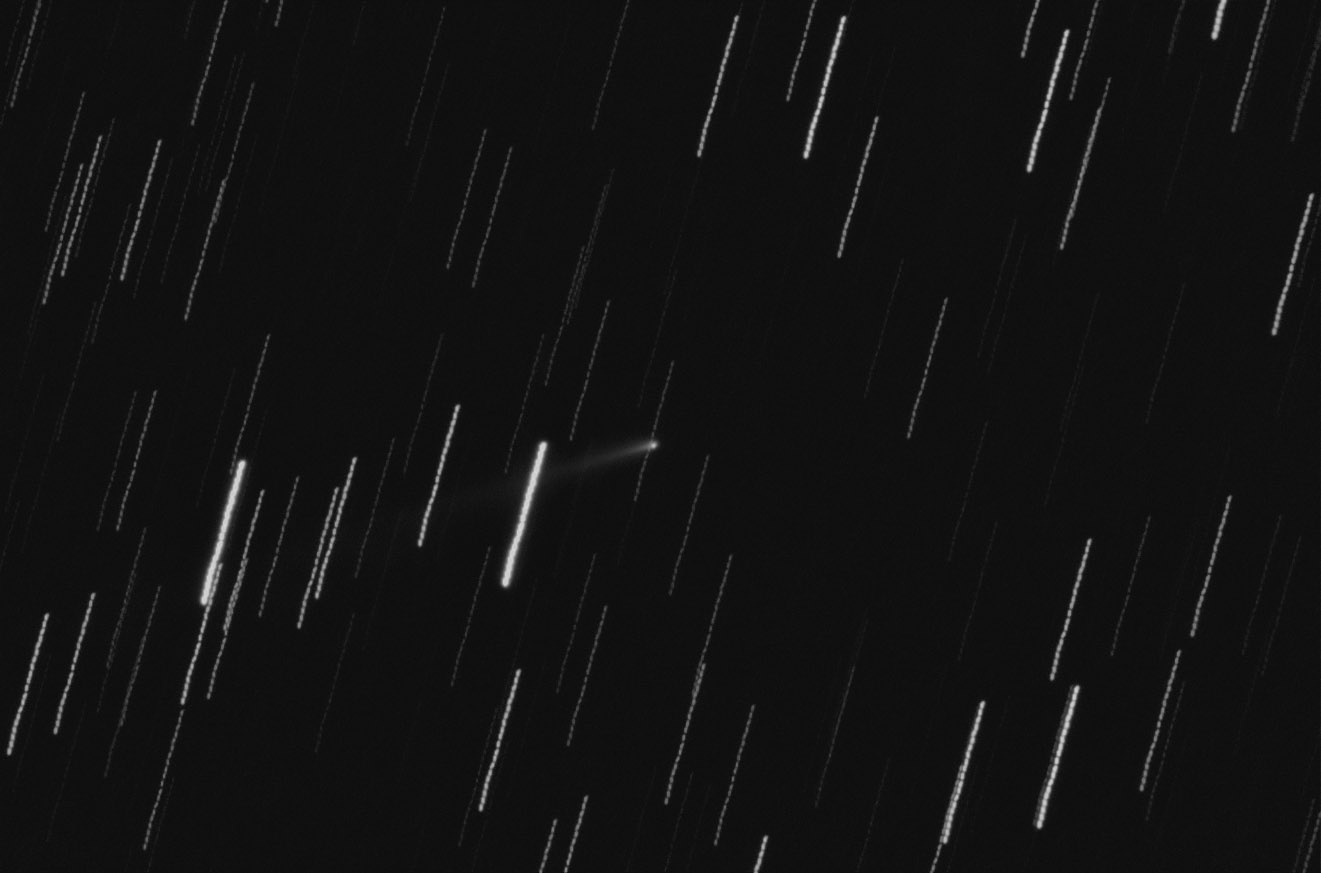
209P20X1X3.JPG
| Asteriod (3200) Phaethon was discovered in 1983. It was originally known as 1983 TB meaning it was found during the first half of October in 1983. Once it's orbit was followed for one full passage in 1985 it got the name Phaethon (from Greek mythology https://en.wikipedia.org/wiki/Phaethon) because it passed closest to the sun of known Apollo asteroid and could endanger the earth, coming within 13 million miles of the sun thus getting far more heating that even Mercury does, some 1400 degrees. It also can pass close enough to the earth to be considered a Potentially Hazardous Asteroid (PHA) though isn't a threat at this time coming no closer to us than 1.8 million miles. But it held another secret, one that was really surprising. Shortly after its orbit was determined it was found to follow a comet-like orbit rather than an asteroid orbit. Then Harlow Shapley found its orbit closely matched that of the particles in the Geminid meteor shower. It took some time for this idea to catch on. Comets made meteor showers from the tons of small particles they shed but asteroids don't shed particles, or so it was thought.
It is now thought the extreme heating it undergoes each orbit causes particles to flake off and it is these that create the Geminid shower. No other source for the Geminid meteor shower has ever been found. Also, the asteroid has been detected suddenly brightening much like a comet can during an eruption. All sorts of ideas have been floated including it is a long-dead comet. Since the particles are thought to be shed when nearest the sun to shortly thereafter it's passage at almost the time of the shower shouldn't have had much influence on the number of meteors shown. Reports vary from only 20 an hour to well over 100 an hour. Rather typical of Geminid showers so apparently that idea is still looking good. I was clouded out here.
With clouds in the forecast, I took the only sort of usable night to catch it passing by. I caught it on the night of December 12 through rather nasty clouds. I'd normally have used a 15 or maybe 30 second exposure to limit the star trailing as the asteroid was plenty bright at magnitude 11 but thanks to the clouds I needed 2 minutes to get it to stand out from the bright cloud background. The constantly varying cloud density caused the stars to vary in brightness greatly as you can see if you stop on any individual frame. The motion of the animation helps hide this, fortunately.
When I took my 20 frames (42 minutes) animation the asteroid was about 10.4 million miles away. Closest it came on the 16th was 6.4 million miles and it was moving much faster. Not knowing when or if it would clear I started the telescope tracking the asteroid even before it got dark. The hole didn't open up until over 6 hours later. One thing I didn't think about was it got 200,000 miles closer and was moving faster in the sky than when I started tracking. I'd locked in the tracking rate at the wrong speed and slightly wrong declination rate. So rather than remaining centered it drift a bit in the animation. I should have refreshed the tracking rate but dummy didn't think of that at the time. Still, it held the asteroid pretty round. I spent hours cleaning up the most cloud damaged star trail, however. To get enough light through the clouds I binned the exposures at 3x3 for 1.5" per pixel resolution. I was planning on a much longer animation (60 frames) but clouds limited me to 20 frames. It snowed every night between the 12 and the closest passage 4 days later with no end of clouds in the forecast. I've seen some great animations of it on the net. This isn't one of them. :(
14" LX200R @ f/10, L=20x2'x3, STL-11000XM, Paramount ME | 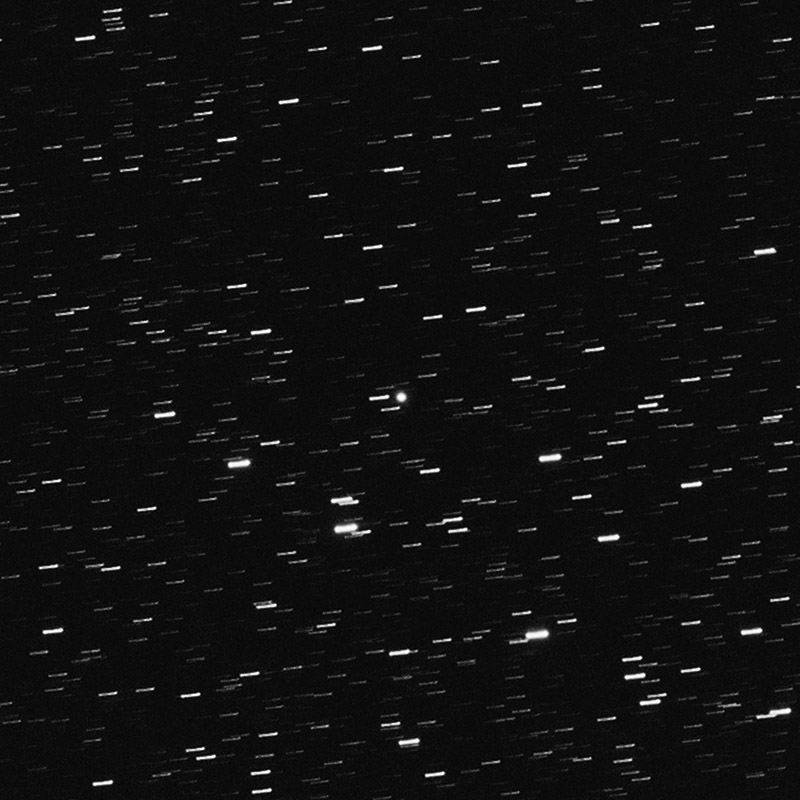
PHAETHON-CROP.JPG
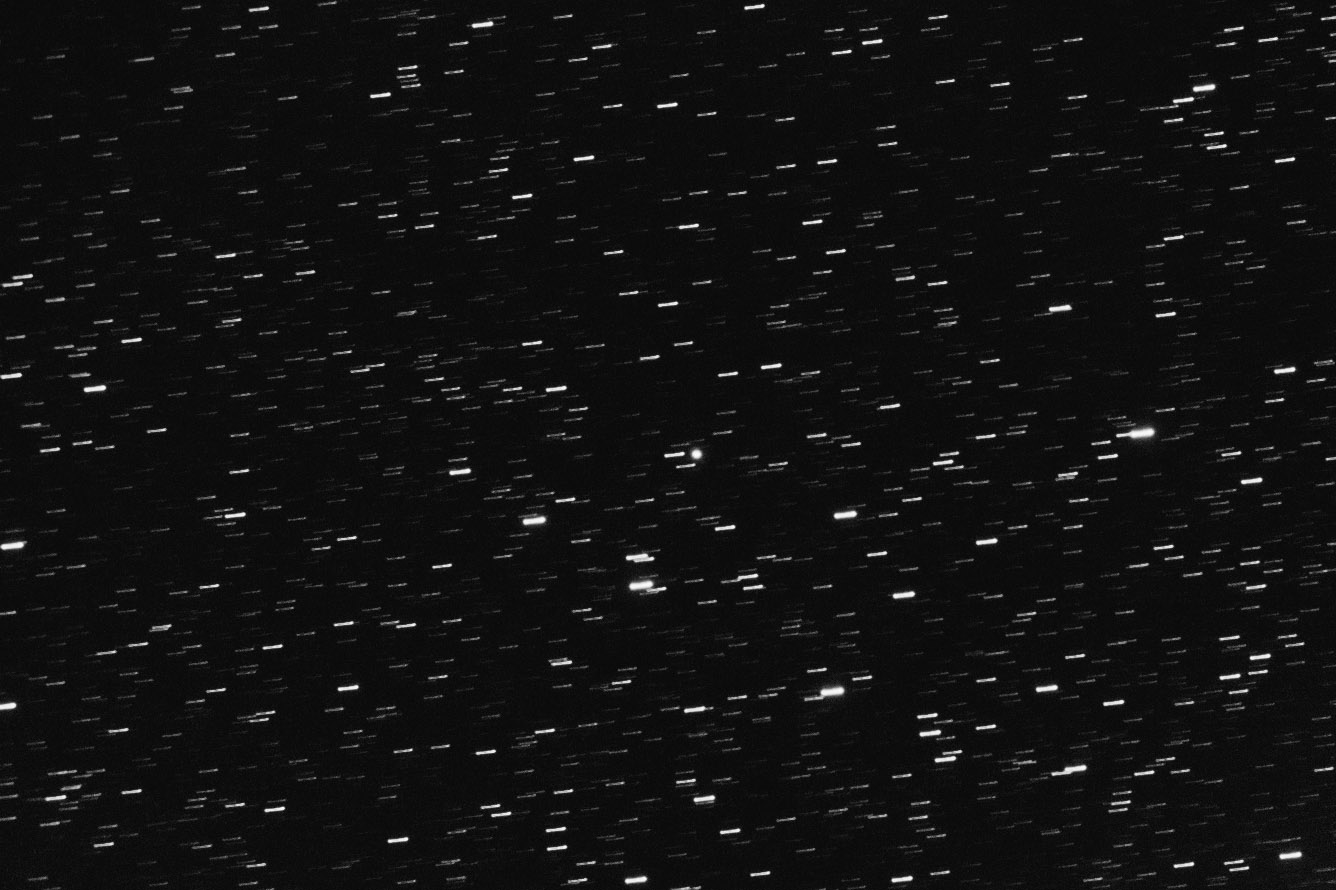
PHAETHON.JPG
Video: https://images.mantrapskies.com//catalog/OTHER/3200PHAETHON/PHAETHON12-14-17.MP4 | NGC 6207 is a much imaged galaxy but almost always because it is in the same field with M13 the rather famous globular cluster to its south southwest. It was on my to-do list as an object in the original Herschel 400 observing program. It was discovered by William Herschel on May 16, 1787. My comments from April 20, 1985 at 120x under fair skies (humidity reduced transparency) with my 10" f/5 are rather sparse reading "Small, oval galaxy, evenly bright. No nucleus seen." That's it. Apparently I wasn't impressed. My image shows a very obvious star near its nucleus. It appears to be about magnitude 13.5 yet I didn't mention it. I assume transparency was worse than I realized that night. It certainly is far brighter than the actual core to the south. So at least I was right that no core was seen. It's not obvious even in my image.
NED classifies it as SA(s)c with HII emission while the NGC Project says S... and Seligman says Sc?. Arm structure is certainly ill defined visually. References to IR images indicate the pattern may be stronger at that wavelength. One paper considers it an isolated spiral galaxy. It references 5 dwarf companions. These are labeled A-E in the annotated image. The paper is at: Http://www.aanda.org/articles/aa/pdf/2008/32/aa09666-08.pdf and includes an IR image showing the spiral pattern a bit better than my image. The field stars are greatly suppressed in IR helping to show what it is hiding.
Distance to this galaxy is a bit of a puzzle. Many web pages say 30 million light-years but none give a reference. NED's redshift says 40 million while non redshift measurements there say about 62 million. So a two times difference. Also the paper mentioned above gives a size as 3 arc minutes. Even using their image I can't see it that large. I get about 2.7 arc minutes. Both on my image and theirs. Maybe they rounded. Using that I get a size of 23,600, 31,400 and 48,700 light-years. Flip that 3 sided coin. Though if the smaller sizes are right those dwarf galaxies are really super dwarfs. Dwarf E I measure at 5 arc seconds which is about 1,500 light-years at the 62 million light-year distance. These are tiny galaxies if the paper is right that they are part of the NGC 6207 system.
The other "major" galaxy usually captured in M13 images is IC 4617 an Sbc spiral according to NED and Sbc? by Seligman. It was discovered by Edward Barnard of dark nebulae fame. I can't find a date for its discovery however. This identification is a bit suspect. Barnard's position, and he was usually very accurate, has nothing but some of M13's stars. This galaxy is almost 1 minute further east and correct in declination. Thus most feel it is the galaxy Barnard found. Even Barnard could get something wrong it would seem. Though Barnard's notes appear to be missing so it could be Dreyer who got the position wrong. I agree with Seligman's length of 45 arc seconds which if the distance of 490 million light-years is correct works out to be a length of 107,000 light-years. Thus while it appears much smaller than NGC 6207 it is really much larger.
There are 3 proven quasars in the field and another 5 likely quasars. The latter are listed as UvES in the annotated image. Arp tried to link fields with lots of galaxies to active galaxies. Since NGC 6207 is not very active at all but for a few HII regions common to many spiral galaxies I wonder how he'd have explained all these quasars. No matter how many such fields were pointed out to him he stuck to his ideas they were ejected from active galaxies and their great redshifts were unrelated to the expansion of the universe but depended on how long it had been since they were ejected. I don't pretend to understand his logic.
I was initially fooled by a galaxy on the western edge of my image ASK 256119. On my FITS images it appeared just like a typical asteroid trail but for being a bit dimmer at either end. I put that down to conditions where weren't all that great for transparency. But turns out the Minor Planet Center shows no asteroids in the field. The galaxy would appear to be a candidate for the Flat Galaxy Catalog but is too faint? It certainly has no significant central bulge.
The stars in the lower right of my image are on the outskirts of M13. That's why there's a sudden increase in stars in that part of the image.
14" LX200R @ f/10, L=4x10' RGB=2x10', STL-11000XM, Paramount ME Related Designations for 3C2733C 273, PG 1226+023, [HB89] 1226+023, 4C +02.32, PKS 1226+02, WISE J122906.69+020308.6, WISE J122906.70+020308.6, 2MASX J12290674+0203083, 2MASS J12290669+0203085, SDSS J122906.69+020308.5, GALEXASC J122906.80+020308.2 , IRAS 12265+0219, IRAS F12265+0219, LQAC 187+002 004, CGRaBS J1229+0203, HE 1226+0219, PGC 041121, RBS 1114, SSTSL2 J122906.70+020308.6, BZQ J1229+0203, PKS B1226+023, PKS J1229+0203, PMN J1229+0203, MRC 1226+023, MG1 J122906+0202, 87GB 122633.1+021928, 87GB[BWE91] 1226+0219, [WB92] 1226+0219, FIRST J122906.7+020308, NVSS J122906+020305, VLSS J1229.0+0202, VSOP J1229+0203, EUVE J1229+02.0, UITBOC 1715, ON +044, CRATES J1229+0203, CRATES J122906.70+020308.6, CTA 053, DA 324, NRAO 0400, TXS 1226+023, Cul 1226+023, CoNFIG 137, CoNFIG2 J122906.41+020305.10 , GB6 J1229+0202, ICRF J122906.6+020308, IERS B1226+023, JVAS J1229+0203, PAPER J187.29+02.09, RGB J1229+020, WB J1229+0203, WIBRaLS J1229+0203, WMAP 170, WMAP J1229+0203, WMAP J122906+0203, NEWPS_5yr_5s 281, NEWPS_5yr_5s_15 272, QVW5 J122907+0203, QVW7 J122906+020310, WMAP3-NEWPS-5S 163, HIP 060936, CXO J122906.6+020308, RX J1229.1+0203, 1RXS J122906.5+020311, IGR J12291+0203, MAXI J1229+020, 2PBC J1229.1+0202, PBC J1229.1+0202, SAXWFC J1229.1+0202.3, 2XMM J122906.6+020308, 2XMMp J122906.6+020308, 1XMM J122906.7+020308, 4U 1226+02, H 1226+023, 1H 1226+022, 1ES 1226+023, 2E 2729, 2A 1225+022, 3A 1226+023, XRS 12260+024, XSS J12288+0200, 3FGL J1229.1+0202, SWIFT J1229.1+0202, 2FGL J1229.1+0202, 1FGL J1229.1+0203, 0FGL J1229.1+0202, 1AGL J1228+0142, EGR J1229+0203, 2EG J1229+0206, 3EG J1229+0210, [KWP81] 1226+02, [dML87] 295, [MHH96] J122906+020306, [POS96] J122906.78+020310.0, RX J1229.1+0203:[BEV98] 001, [VCV2001] J122906.7+020308, 3C 273:[CME2001] 01, RX J1229.1+0203:[ZEH2003] 01 , [SMI2006] 02, [FBS2007] 48, [HRT2007] J122906+020245, [JBB2007] J122906.70+020308.6 , [KRL2007] 118, [CW2008] J122909+020259, [LLK2008] 1226+023, [DFD2009] J1229+0203, [FCC2009] 096, [MGL2009] 1478, [WMR2009] 093, [GBW2010] CoNFIG1 135, [TES2010] 040, [SBW2011] 43, 3C 273:[PWC2011] 2843, [BTM2013] 0619, [AHG2014] B015, [XH2014] J187.2779+02.0525, [ZZ2014] J122906.69+020308.6 , 3C273, LAMOST J122906.70+020308.6, UVQS J122906.70+020308.6, | 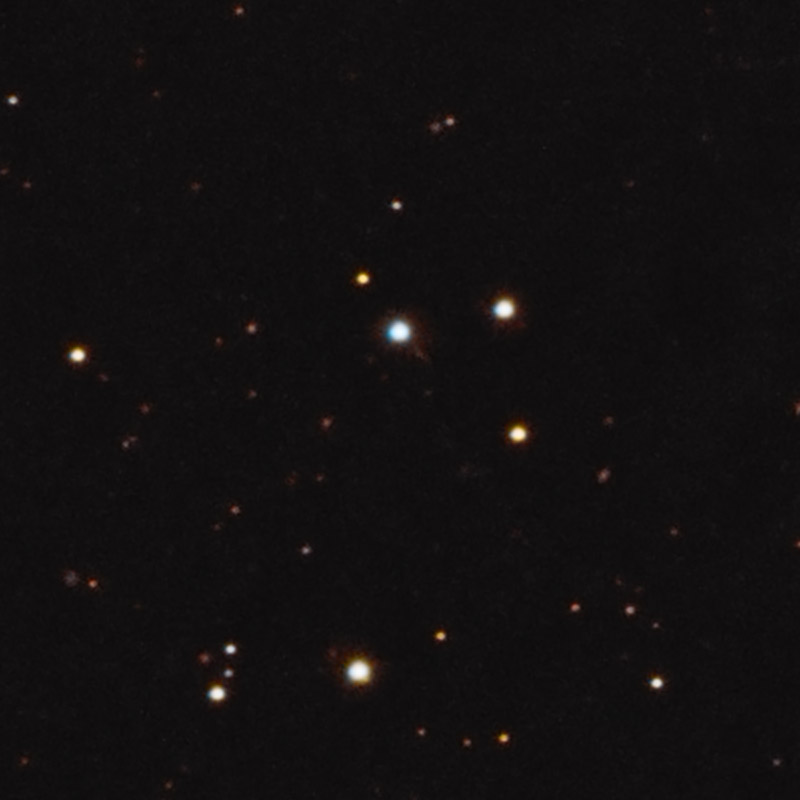
3C273L4X10RGB2X10-200.JPG
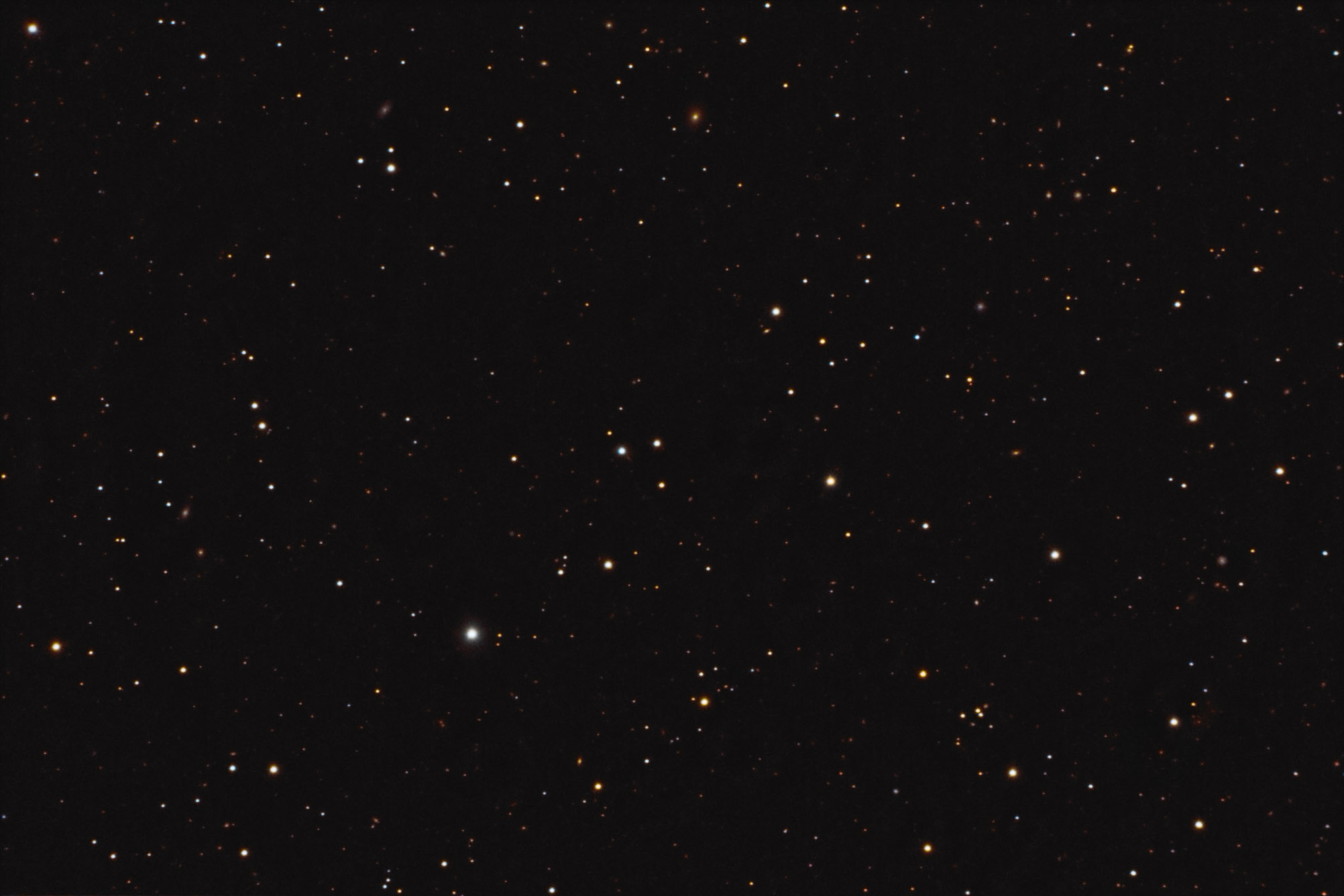
3C273L4X10RGB2X10.JPG
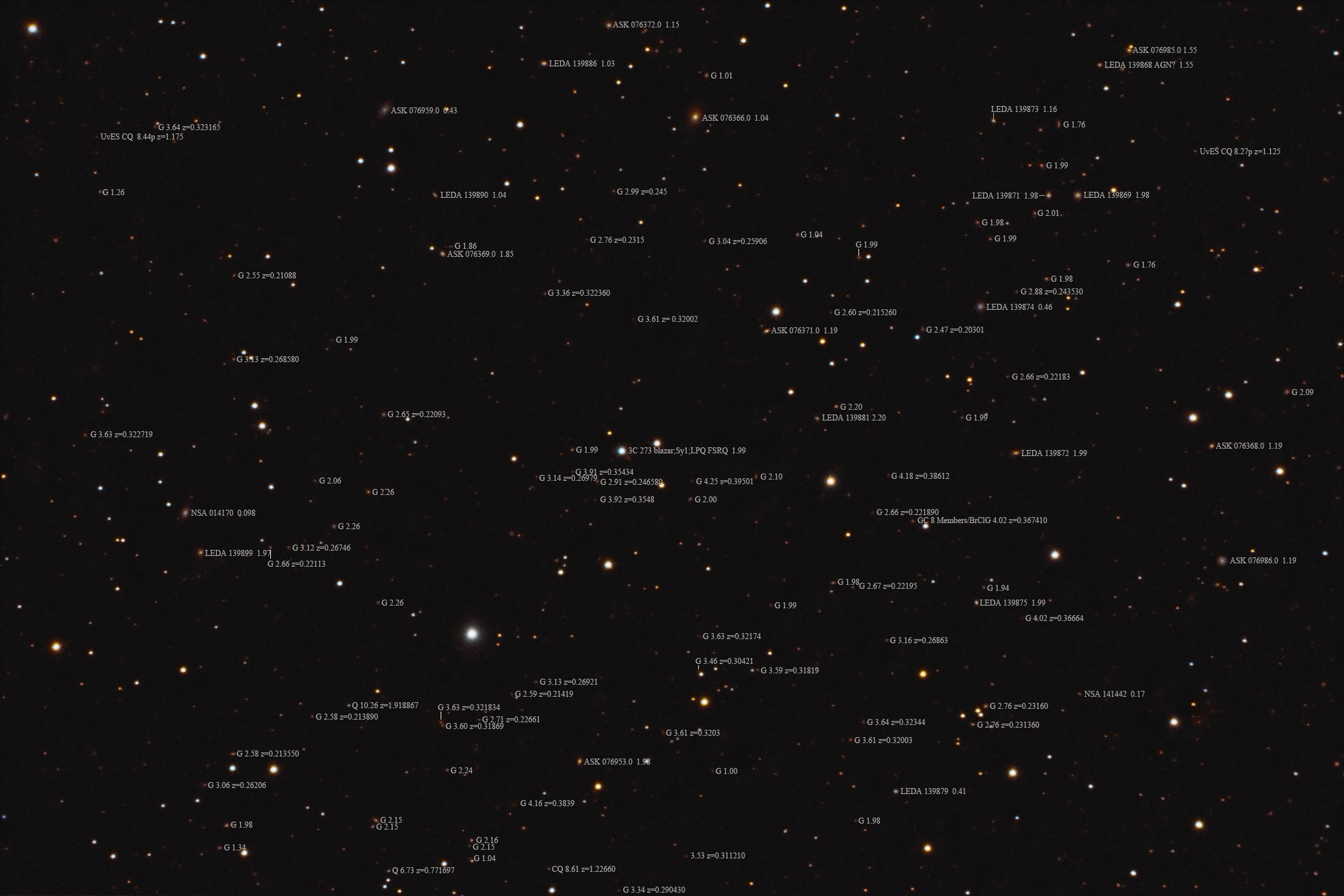
3C273L4X10RGB2X10ID.JPG
| I took this area of the sky several years ago but wasn't happy with the color so gave it another try though the clouds did another number on it the result is a bit better. Abell 194 is a galaxy cluster a bit under a quarter of a billion light-years distant seen in the constellation of Cetus so runs rather low in my sky which doesn't help. It is far larger than my field of view being 3.75 degrees across. I aimed pretty much for the center which put its two Arp Atlas entries a bit off center to the upper left. Some of the text below is from my original attempt on this area.
Arp 133 falls under Arp's very odd category of galaxies with nearby fragments. It consists of two galaxies; NGC 541, the large cD/S0 galaxy and the "fragment". They lie to the southwest of a pair of elliptical galaxies that are Arp 308. The "fragment" is the very blue dwarf galaxy to its northeast (upper left). This is not a fragment at all but a dwarf galaxy undergoing extreme starburst star formation. It is known as Minkowski's Object. NGC 541 is a radio galaxy with jets. One is directed directly at Minkowski's Object and is credited with triggering the starburst activity. Minkowski's Object has a different redshift but this is more an indication of relative velocity than a real distance difference. Arp 133 with its blue companion galaxy is almost identical in appearance to the much nearer Arp 134 (M49 and its blue "fragment" UGC 07636.) http://www.spacebanter.com/attachment.php?attachmentid=2440&stc=1 Both give me the impression that the "fragment" is a bug splat on the leading edge of a "solid" galaxy that ran into it.
Arp had no knowledge of this at the time of his image. His image carries a note that it was taken with a "Polaroid" filter. I assume he means polarizing filter. How it was aligned it doesn't say. Arp's comment on the image reads: "Central member of galaxy group associated with 3C40." 3C40 is a strong radio source but not the radio source involved with the starburst activity in Minkowski's Object. But it does bring us to Arp 308.
Arp 308 is a pair of galaxies; NGC 545 and NGC 547 that are associated with the radio source 3C40. That is NGC 547 is considered to be the source of 3C40 along with the small galaxy CGG 385-129 to the west. Arp put the NGC pair in his category of simply double galaxies. His simple remark says: "Close ellipticals." which isn't very informative. NGC 545 to the north is listed as an SA0 galaxy while NGC 547 is E1 and a bright cluster galaxy. Redshift puts it at 6 million light-years further from us than NGC 545. However, NED gives a D-Sigma distance determination that is the same for both. Likely the difference in radial velocity is due to relative motion rather than distance. The exact same D-Sigma distance is found for NGC 541 (Arp 133) as well. Several sources say the pair are not interacting. It does appear to me that NGC 547 lies in front of NGC 545 based on the dark band between their cores which could be caused by dust in NGC 547 blocking the light of NGC 545 behind it.
NGC 519, 538, 557 was discovered by Lewis Swift on November 20, 1886
NGC 535, 543 was discovered by Heinrich d'Arrest on October 31, 1864
NGC 541 (Arp 133) was discovered by Heinrich d'Arrest on October 30, 1864
NGC 545, 547 (Arp 308) was discovered by William Herschel on October 1, 1785
Neither of Herschel's discoveries are in either H400 observing program.
There's one asteroid in the image. Its information is noted in the annotated image.
The annotated image includes the classification of each galaxy by NED. That of the NGC project for NGC galaxies is listed after the NED classification if different. When the same there is no second entry. Note only NGC galaxies are classified by the NGC Project.
Arp's image of Arp 133 with an asteroid trail:
http://ned.ipac.caltech.edu/level5/Arp/Figures/big_arp133.jpeg
Arp's image of Arp 308
http://ned.ipac.caltech.edu/level5/Arp/Figures/big_arp308.jpeg
My image from November 2011
http://www.spacebanter.com/attachment.php?attachmentid=3840&d=1322593005
14" LX200R @ f/10, L=4x10' RGB=2x10' STL-11000XM, Paramount ME Related Designations for ABELL0194ABELL 0194, UGCl 025, USGC U064, ZwCl 0123.6-0133, MCXC J0125.6-0124, RASSCALS SRGb 103, RXC J0125.6-0124, RXC J0125.6-0125, [LSL2000] +0123.4-01.60, NGC 0530, IC 0106, UGC 00965, CGCG 385-108, CGCG 0122.1-0150, MCG +00-04-119, 2MFGC 01088, 2MASX J01244163-0135134, 2MASXi J0124416-013513, 2MASS J01244166-0135135, GALEXASC J012441.61-013512.2 , GALEXMSC J012441.65-013512.8 , WBL 045-005, LDCE 0089 NED006, HDCE 0075 NED005, USGC U064 NED01, NSA 129449, PGC 005210, LEDA 073947, UZC J012441.7-013515, ABELL 0194:[ZH64] 13, ABELL 0194:[ASS80] 02, ABELL 0194:[D80] 025, LGG 022:[G93] 003, [BDG98] J012441.7-013516, [M98j] 021 NED02, [DZ2015] 535-03, NGC 0535, UGC 00997, CGCG 385-124, CGCG 0123.0-0139, MCG +00-04-133, 2MASX J01253116-0124291, 2MASXi J0125311-012429, 2MASS J01253113-0124294, 2MASS J01253127-0124278, GALEXASC J012531.21-012427.4 , GALEXMSC J012531.09-012429.5 , WBL 045-013, LDCE 0089 NED011, HDCE 0075 NED010, USGC U064 NED02, NSA 129556, PGC 005282, UZC J012531.1-012430, ABELL 0194:[ZH64] 04, ABELL 0194:[ASS80] 06, ABELL 0194:[D80] 035, ABELL 0194:[LGC91] 0121, LGG 022:[G93] 006, [BDG98] J012531.2-012430, [GD2000] 6, [DZ2015] 535-08, NGC 0538, UGC 00991, CGCG 385-120, CGCG 0122.9-0148, MCG +00-04-130, 2MASX J01252603-0133021, 2MASXi J0125260-013302, 2MASS J01252605-0133024, GALEXASC J012526.06-013302.1 , GALEXMSC J012526.02-013301.8 , WBL 045-010, LDCE 0089 NED010, HDCE 0075 NED009, USGC U064 NED06, NSA 129548, PGC 005275, UZC J012526.1-013303, ABELL 0194:[ZH64] 06, ABELL 0194:[ASS80] 03, ABELL 0194:[D80] 023, ABELL 0194:[LGC91] 0132, LGG 025:[G93] 010, [BDG98] J012526.1-013303, [GD2000] 4, RSCG 10:[WBJ2013] A, [DZ2015] 535-06, NGC 0541, UGC 01004, ARP 133, CGCG 385-128, CGCG 0123.2-0137, MCG +00-04-137, 2MASX J01254430-0122461, 2MASXi J0125443-012246, 2MASS J01254430-0122460, WBL 045-016, LDCE 0089 NED014, HDCE 0075 NED013, USGC U064 NED04, APMUKS(BJ) B012311.26-013820.9, NSA 129581, PGC 005305, SSTSL2 J012544.28-012246.2, UZC J012544.3-012247, NVSS J012543-012241, CXO J012544.3-012246, 2XMM J012544.3-012245, 2XMMp J012544.3-012246, XMMU J012544.2-012247, ABELL 0194:[ZH64] 03, ABELL 0194:[ASS80] 01, ABELL 0194:[D80] 034, ABELL 0194:[L84] G2, [OSO87] 0123-016A, ABELL 0194:[ZBO89] O2, ABELL 0194:[ZBO89] R2, ABELL 0194:[LGC91] 0118, LGG 025:[G93] 011, [BDG98] J012544.4-012247, [M98j] 021 NED03, ABELL 0194:[LCR98] 12, ABELL 0194:[NDG99] B, [GD2000] 7, ABELL 0194:[HKT2006] 08, [LPP2009] 0123-016A, RSCG 11:[WBJ2013] C, [DZ2015] 535-02, NGC 0543, CGCG 385-130, CGCG 0123.3-0132, MCG +00-04-138, 2MASX J01254997-0117341, 2MASXi J0125499-011734, 2MASS J01254998-0117340, GALEXASC J012549.98-011733.9 , GALEXMSC J012549.84-011738.5 , WBL 045-017, LDCE 0089 NED015, HDCE 0075 NED014, USGC U064 NED31, APMUKS(BJ) B012316.83-013308.8, NSA 129590, PGC 005311, UZC J012550.0-011734, ABELL 0194:[ZH64] 10, ABELL 0194:[ASS80] 10, ABELL 0194:[D80] 053, ABELL 0194:[LGC91] 0105, LGG 025:[G93] 002, [BDG98] J012550.0-011735, RSCG 11:[WBJ2013] D, [DZ2015] 535-10, ARP 308, 3C 040, 4C -01.08, PKS 0123-01, KPG 032, APMUKS(BJ) B012326.77-013606.0, HOLM 042, PKS B0123-016, PKS J0126-0120, 87GB[BWE91] 0123-0136, [WB92] 0123-0136, NVSS J012600-012052, S3 0123-01, OC -039, CTA 012, DA 042, NRAO 0070, LHE 029, MSH 01-005, CXO J012600.6-012024, 1WGA J0126.0-0120, EXSS 0123.4-0135, [KWP81] 0123-01, ABELL 0194:[NDG99] A, [SM2000] 0123-016B, [LPP2009] 0123-016B, NGC 0547, UGC 01009, ARP 308 NED02, CGCG 385-133, CGCG 0123.5-0136, MCG +00-04-143, 2MASX J01260057-0120424, 2MASXi J0126006-012042, 2MASS J01260061-0120426, KPG 032B, 6dF J0126006-012043, WBL 045-020, LDCE 0089 NED016, HDCE 0075 NED015, USGC U064 NED37, BMW-HRI J012600.2-012040, BMW-HRI J012600.4-012039, BMW-HRI J012600.7-012040, LQAC 021-001 005, HOLM 042B, NSA 129602, PGC 005324, SSTSL2 J012600.61-012042.4, UZC J012600.6-012046, AT20G J012600-012041, CXO J012600.6-012042, 2XMM J012600.5-012041, 2XMMp J012600.5-012041, XMMU J012600.5-012043, ABELL 0194:[ZH64] 02, ABELL 0194:[D80] 042, ABELL 0194:[ZBO89] O1 NED01, ABELL 0194:[LGC91] 0110, LGG 025:[G93] 015, [BDG98] J012600.6-012043, [M98j] 021 NED05, ABELL 0194:[LCR98] 03, ABELL 0194:[HKT2006] 01, [HBW2011] J012600.62-012042.5 , [MSC2011] J012600.36-012038.2 , RSCG 11:[WBJ2013] A, [DZ2015] 535-01, NGC 0557, IC 1703, UGC 01016, CGCG 385-136, CGCG 0123.8-0154, MCG +00-04-144, 2MASX J01262516-0138195, 2MASXi J0126251-013819, 2MASS J01262514-0138192, SDSS J012625.12-013819.2, GALEXASC J012625.08-013819.9 , GALEXMSC J012624.99-013818.8 , 6dF J0126252-013819, 6dFGSv 00800, WBL 045-023, LDCE 0089 NED017, HDCE 0075 NED016, USGC U064 NED05, APMUKS(BJ) B012352.10-015352.6, NSA 129641, PGC 005351, UZC J012625.1-013820, ABELL 0194:[ZH64] 17, ABELL 0194:[ASS80] 04, ABELL 0194:[D80] 017, [BDG98] J012625.1-013820, [DZ2015] 535-05, SDSS J012547.03-012218.4, APMUKS(BJ) B012314.23-013754.6, LEDA 073957, SSTSL2 J012547.34-012220.9, ABELL 0194:[D80] 037, ABELL 0194:[NFS85] 104, ABELL 0194:[LGC91] 0116, [BDG98] J012547.4-012221, IC 1696, UGC 00973, CGCG 385-113, CGCG 0122.3-0152, MCG +00-04-122, 2MASX J01245237-0137014, 2MASXi J0124523-013701, 2MASS J01245234-0137012, GALEXASC J012452.36-013700.0 , GALEXMSC J012452.33-013700.0 , 6dF J0124524-013701, 6dFGSv 00786, WBL 045-007, LDCE 0089 NED007, HDCE 0075 NED006, USGC U064 NED11, APMUKS(BJ) B012219.32-015237.4, NSA 129471, PGC 005231, UZC J012452.3-013701, ABELL 0194:[ZH64] 24, ABELL 0194:[ASS80] 05, ABELL 0194:[D80] 018, [BDG98] J012452.4-013702, [DZ2015] 541-01, ABELL0194, NGC0530, NGC0535, NGC538, NGC0541, NGC0543, ARP308, NGC0547, NGC0557, MINKOWSKIS OBJECT, IC1696, SDSS J012441.65-013513.4, SDSS J012526.05-013302.3, SDSS J012544.31-012246.4, SDSS J012549.99-011734.1, SDSS J012600.63-012042.5, NVGRC J012600.6-012052, SDSS J012625.15-013819.3, SDSS J012547.39-012221.0, SDSS J012452.36-013701.4, | 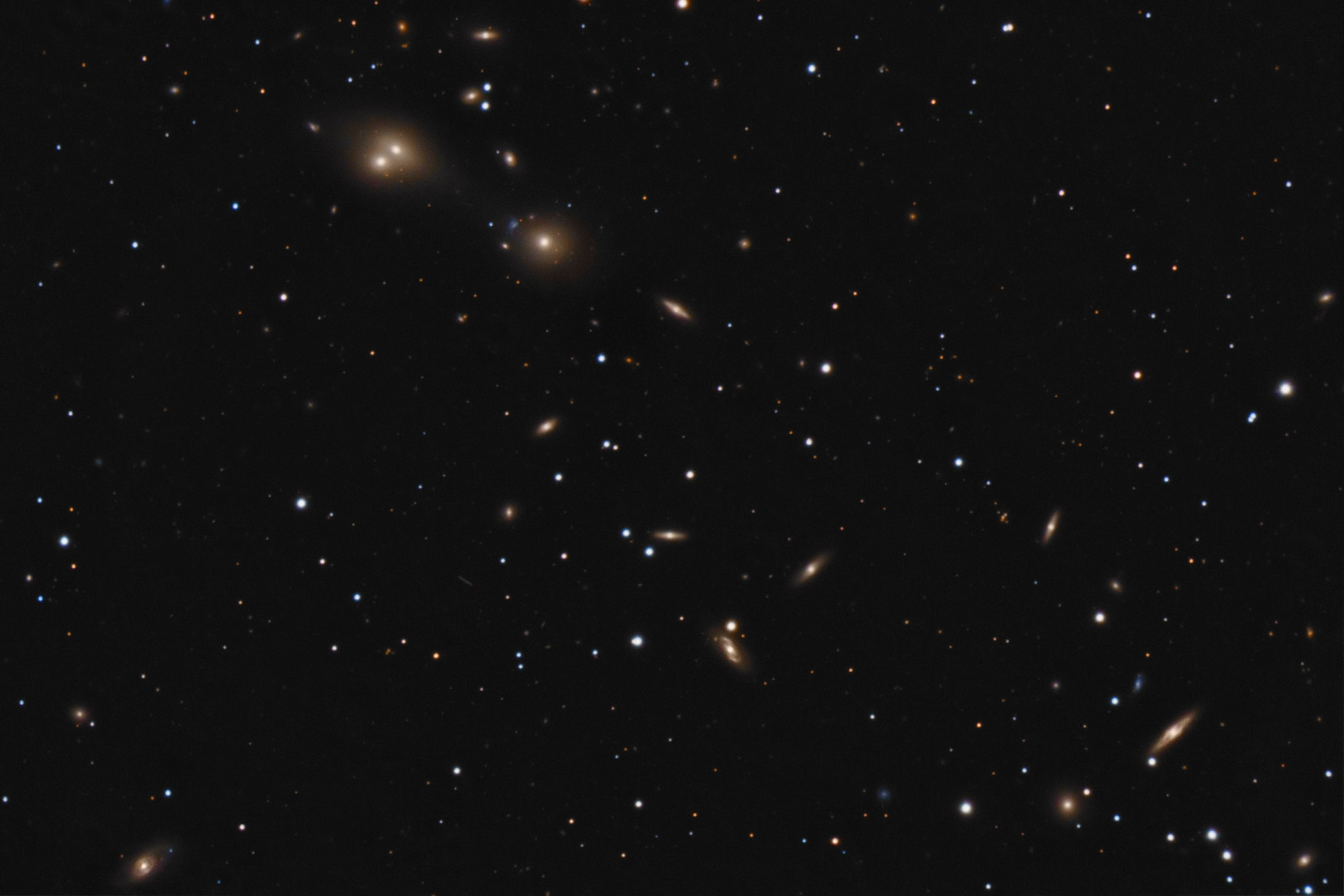
NGC535L4X10RGB2X10.JPG
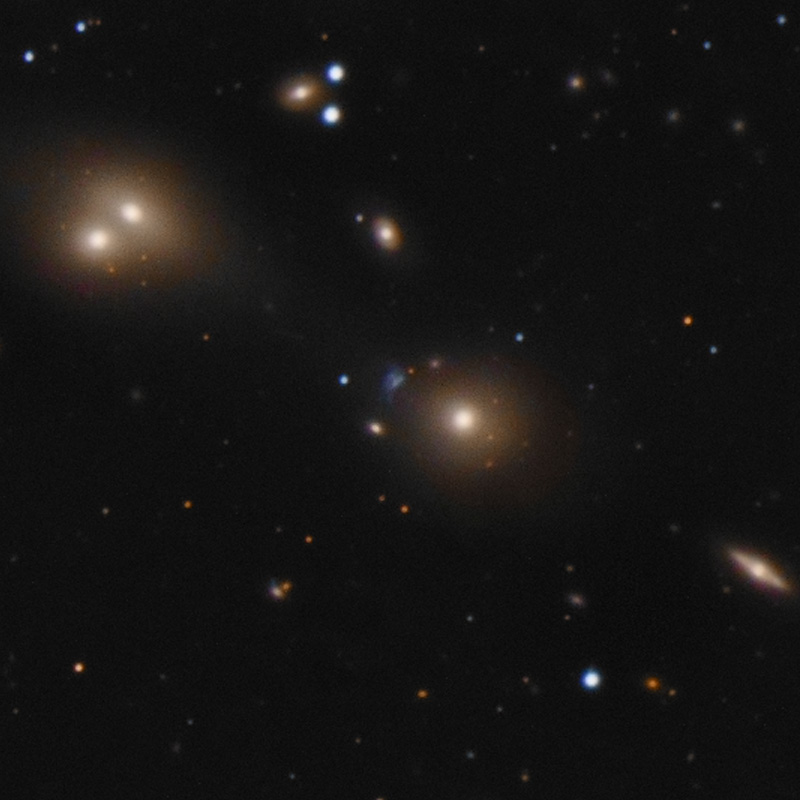
NGC535L4X10RGB2X10CROP150.JPG
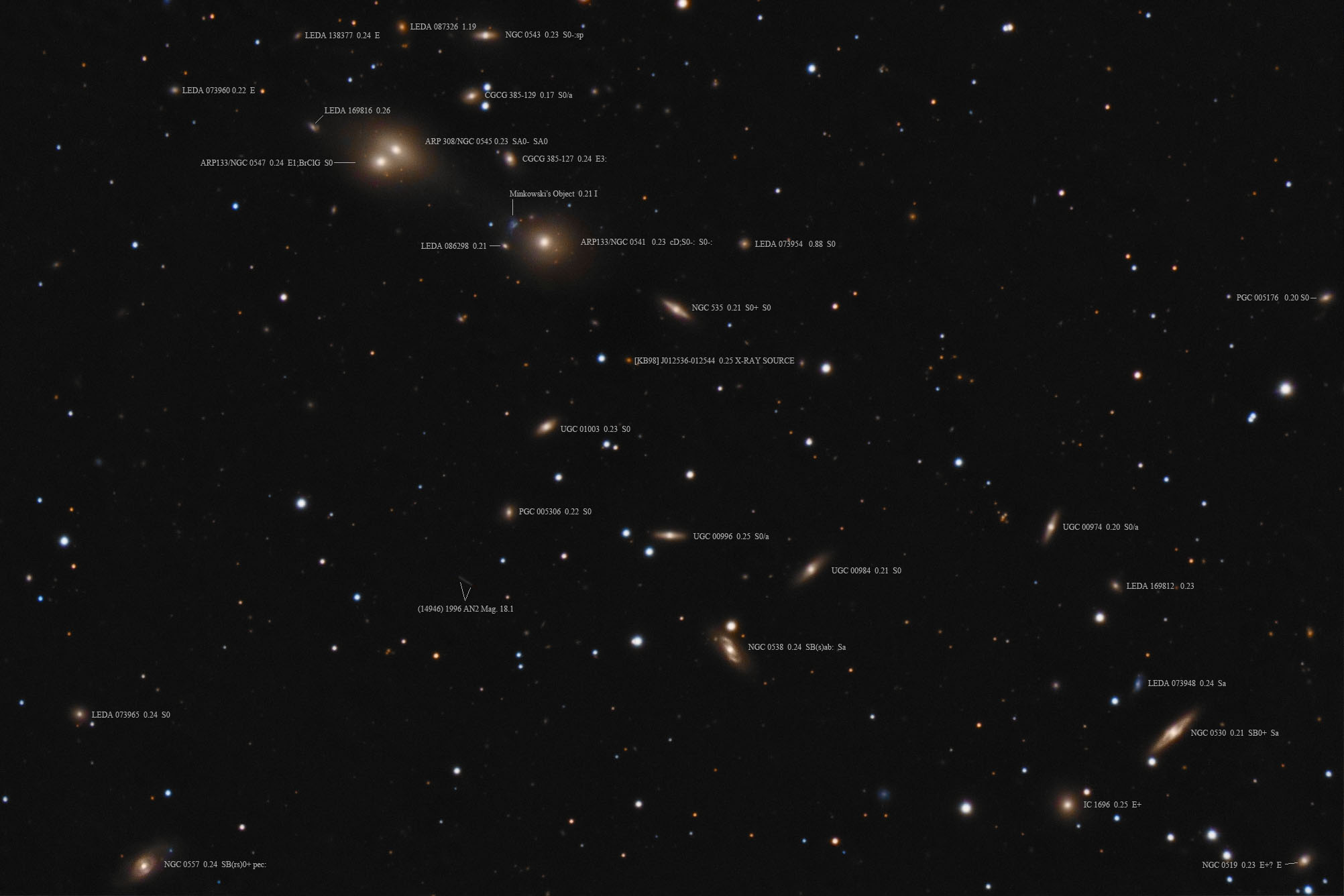
NGC535L4X10RGB2X10ID.JPG
| Abell 347 is a large galaxy cluster just three quarters of a degree southeast of the far more well-known edge-on galaxy NGC 891 in Andromeda. NED lists the cluster as being some 240 million light-years distant. They list it as morphology class II-III meaning it has several Cd galaxies but no condensation that defines a core region. They show it as huge with a diameter of 863 arm minutes -- over 14 degrees! Yet it is listed as richness class 0 which is only 30 to 49 galaxies. I have far more than that in the image though which are true members is difficult to say. The annotated image lists all with a redshift at NED. All had a redshift consistent with being cluster members so I didn't include the distance. All would be in the 240 million light-year range with differences due to relative motion around the cluster's center of gravity.
NGC 910 is the Cd galaxy closest to the center coordinates of the cluster so that is where I centered the image. While NGC 891 is within the cluster radius it is a nearby galaxy by comparison and not a member of the cluster and falls well outside my image frame. Both NED and the NGC project show NGC 911 near the top of the frame as being an elliptical galaxy. Yet it has the appearance of a disk galaxy that is either S0 or Sa with a very obvious dust lane. I suppose that dust lane could be due to a spiral it ate recently à la Centaurus A and the apparent disk an illusion but I am having a hard time buying that. It is red for a spiral but then so is UGC 01866 to the west-northwest of NGC 0910 which is listed as a barred spiral. UGC 1858 is another rather red barred spiral though there's a hint of blue in its outer arm structure. NGC 913 is listed as elliptical but looks more S0 like to me.
NGC 910 was discovered by William Herschel on October 17, 1786. It isn't in either H400 observing program. NGC 911, 912 and 913 were discovered by Édouard Stephan on October 30, 1878.
There are a handful of very blue but small in angular size galaxies in the image. None had redshift data so I don't know if they are dwarf members of the cluster or distant background galaxies.
This is my last 2013 image unless one is still hiding someplace on my hard drive. Not a highly unlikely possibility. Assuming this is really the last 2013 object I'll be finally moving into the current year next posting. While December was very poor for imaging January was better in that I was able to capture more objects, the skies weren't up to normal standards many nights limiting quality many of those nights.
14" LX200R @ f/10, L=4x10' RGB=2x10', STL-11000XM, Paramount ME Related Designations for ABELL0347ABELL 0347, ZwCl 0303.0+4125 NED01, SCL 040 NED02, NGC 0910, UGC 01875, CGCG 539-017, CGCG 0222.3+4136, MCG +07-06-014, 2MASX J02252677+4149275, 2MASXi J0225267+414927, 2MASS J02252678+4149273, WBL 071-008, LDCE 0224 NED019, HDCE 0137 NED016, USGC U120 NED11, HFLLZOA F270, HFLLZOA G141.10-17.71, PGC 009201, UZC J022526.8+414927, ABELL 0347:[PL95] BCG, [SLH97] B09, ABELL 0347:[BTM97] 1, NGC 0911, UGC 01878, CGCG 539-021, CGCG 0222.6+4145, MCG +07-06-016, 2MASX J02254239+4157225, 2MASXi J0225423+415722, 2MASS J02254238+4157226, WBL 071-011, LDCE 0224 NED021, HDCE 0137 NED018, USGC U120 NED08, HFLLZOA F207, HFLLZOA G141.10-17.57, PGC 009221, UZC J022542.4+415722, [SLH97] B10, NGC 0912, CGCG 539-020, CGCG 0222.6+4133, MCG +07-06-015, 2MASX J02254278+4146385, 2MASXi J0225427+414638, 2MASS J02254274+4146386, WBL 071-010, LDCE 0224 NED022, HDCE 0137 NED019, USGC U120 NED10, HFLLZOA F272, HFLLZOA G141.17-17.73, NPM1G +41.0069, PGC 009222, UZC J022542.7+414638, [SLH97] B11, NGC 0913, 2MASX J02254463+4147580, 2MASXi J0225446+414758, 2MASS J02254464+4147578, USGC U120 NED04, HFLLZOA F271, HFLLZOA G141.17-17.71, PGC 009230, UZC J022544.7+414757, ABELL0347, NGC0910, NGC0911, NGC0912, NGC0913, | 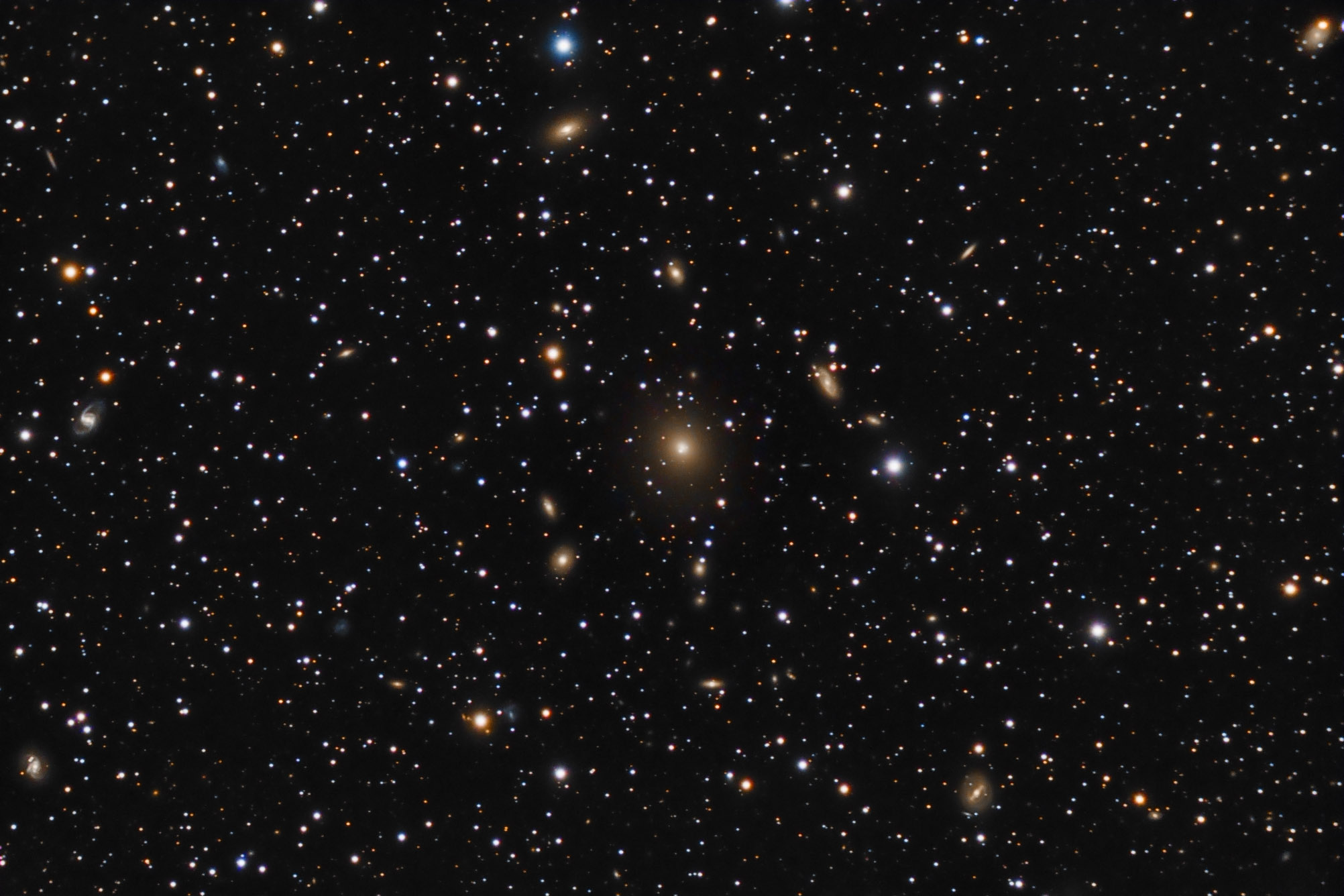
NGC0910L4X10RGB2X10.JPG
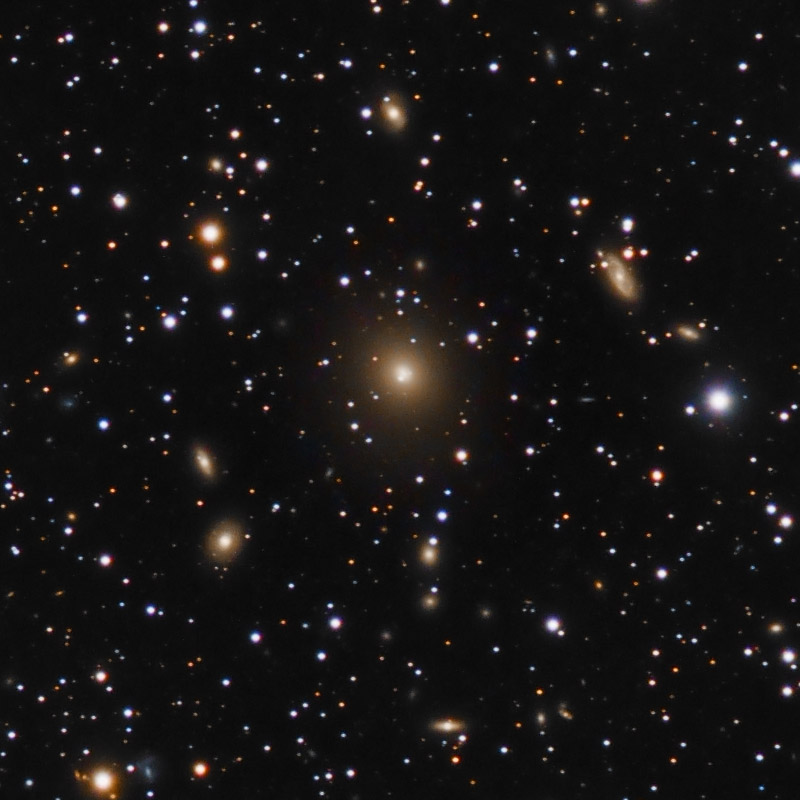
NGC0910L4X10RGB2X10CROP.JPG
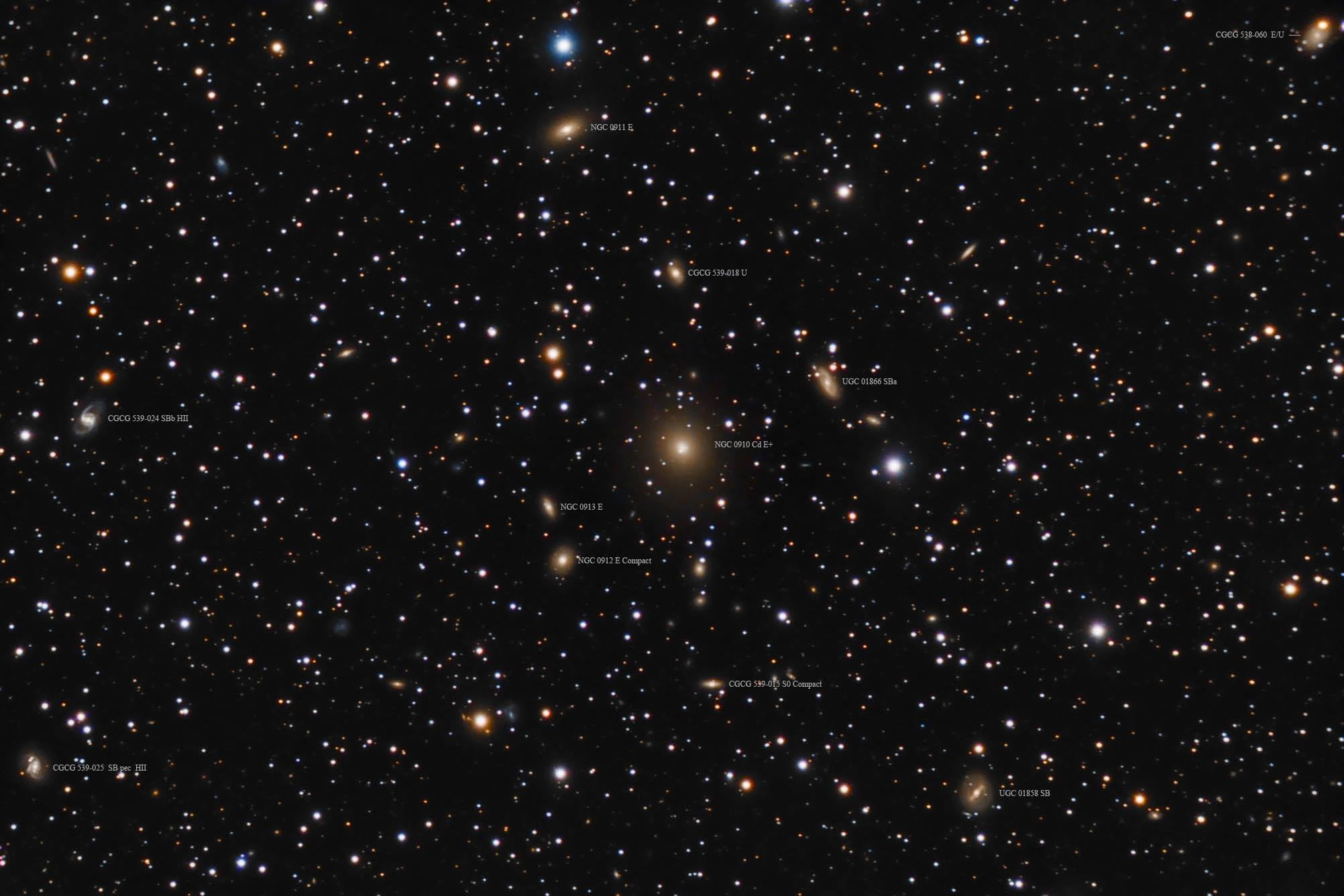
NGC0910L4X10RGB2X10ID.JPG
| ABELL 370 is a galaxy cluster about 4 billion light-years distant. It is located in the constellation of Cetus the whale about 1.6 degrees south of M77. NED lists it as having a diameter of 11 minutes of arc with less than 50 members. It is famous for a rather bright gravitational arc around near the southernmost of the two brightest galaxies in the cluster. I'd hoped to pick it up but the night was poor both for transparency and for seeing. So this is one of my failures. I've meant to go back and try again but whenever it has come up seeing or transparency (sometimes both) haven't been up to it. Thus it hasn't happened as yet. See the HST image at https://www.eso.org/public/images/eso9857c/ which is oriented the same as mine to see what I missed. There's a hint of it but not enough to say it isn't just noise mixed with other galaxies. The yellow galaxy in the HST image is the bright white one in my image.
The asteroid at the far right of my image with a surprisingly long trail is (16532) 1991 LY listed at magnitude 18.2 but appearing far fainter due to its rapid motion as well as the poor transparency.
14" LX200R @ f/10, L=8x10' RGB=2x10', STL=11000XM, Paramount ME | 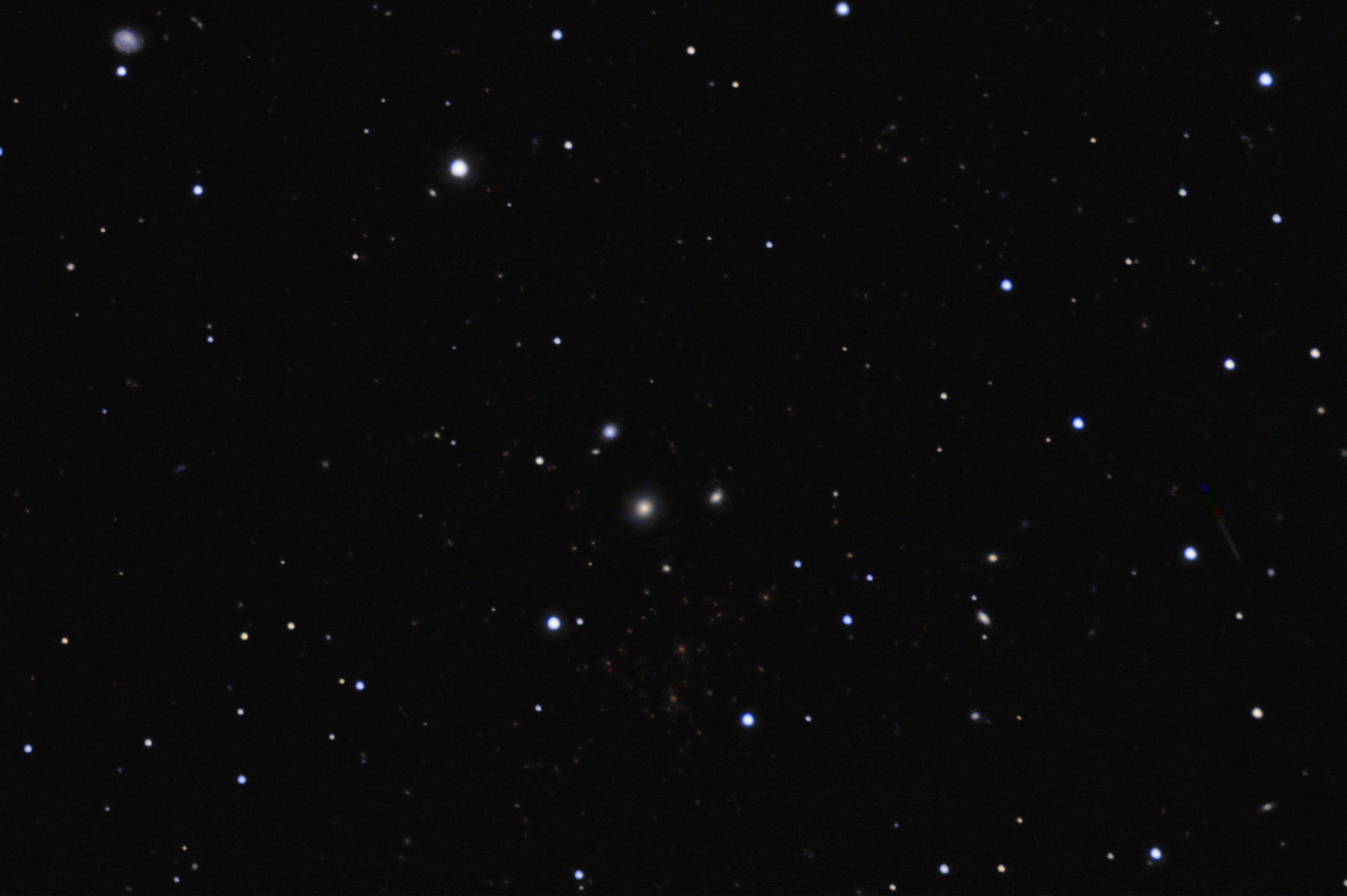
ABELL370L8X10RGB2X10.JPG
| The Abell Galaxy Cluster is located in Orion, not a constellation you'd look to for galaxy clusters. Some claim it looks like the constellation of Orion itself. I see three galaxies in a line much like the belt stars of Orion but they are vertical rather than nearly horizontal. To make the rest of the constellation I have to include stars as well as galaxies. Maybe you can see the similarity that I can't, but then I don't see Jesus in burnt toast either.
The cluster is possibly made up of two clusters, one about 350 to 400 million light-years distant and another from 410 to 460 million light-years away by redshift. It may be they are two groups at about the same distance but with different mean recessional velocities. Like with most galaxy clusters most members are elliptical or S0 galaxies, likely due to chowing down on smaller members in the past. NED lists the cluster as having a diameter of nearly 6 degrees. Obviously, I can't fit that in my 0.2 square degree field of view so I settled on just the core region. It is classed as BM III which means it has no central galaxy. But the center of the cluster does have UGC 3274 which is made up of 6 galaxies. The three brightest make up the vertical "Belt" I mentioned. I've noted the UGG 3274 members under their LEDA or PGC designations on the annotated image as 6 galaxies with the same UGC number gets confusing and adding NED01 or NED03 etc. to the UGC number would not fit well in such tight quarters. One without redshift data is from the VV catalog, which lists them as VV161 plus a letter, is shown as VV161d as it had no LEDA or PGC designation that I found. Also while Abell said it has no central galaxy I see NED indicates that LEDA 075312 is the Bright Cluster Galaxy and it is the center of the three bright "belt" galaxies.
The portion of the cluster in my image has one entry from the Flat Galaxy Catalog at the top as well as three others from the 2 Micron Flag Galaxy Catalog. The latter has far less stringent requirements for entry in the catalog so they aren't as flat as FGC 0528.
Seeing wasn't up to what I'd have liked but transparency was average which, is excellent for how the year was (and is) going. Fortunately, there's not a lot of detail to be seen in S0 and elliptical galaxies.
14" LX200R @ f/10, L=4x10' RGB=2x10', STL-11000XM, Paramount ME | 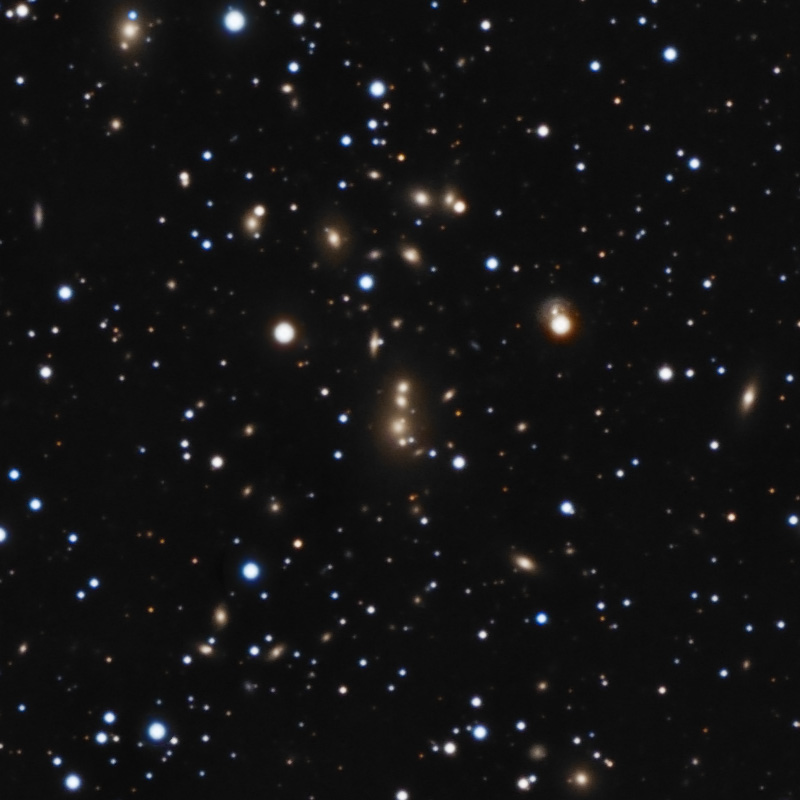
PGC75312L4X10RGB2X10CROPR1.JPG
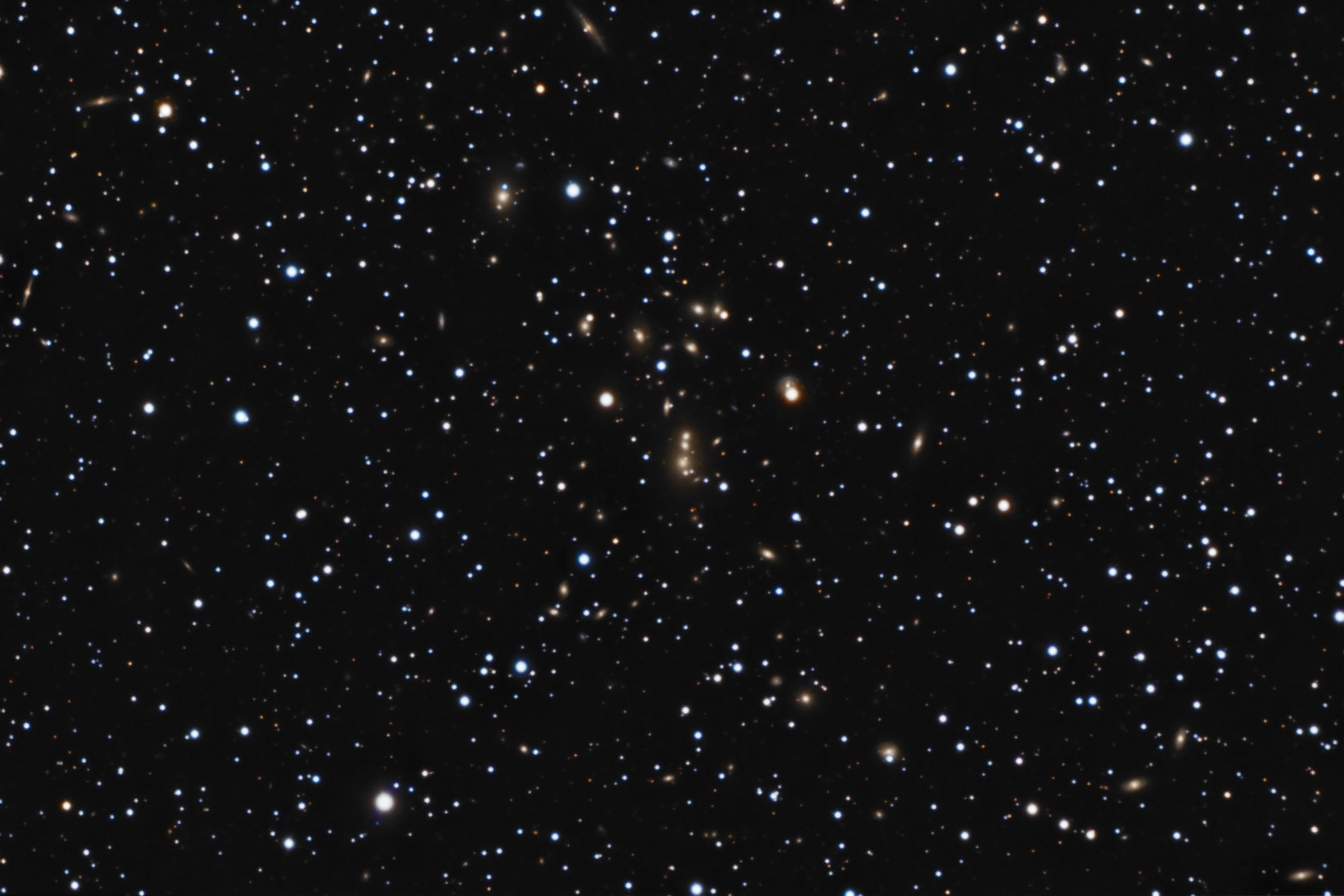
PGC75312L4X10RGB2X10R1.JPG
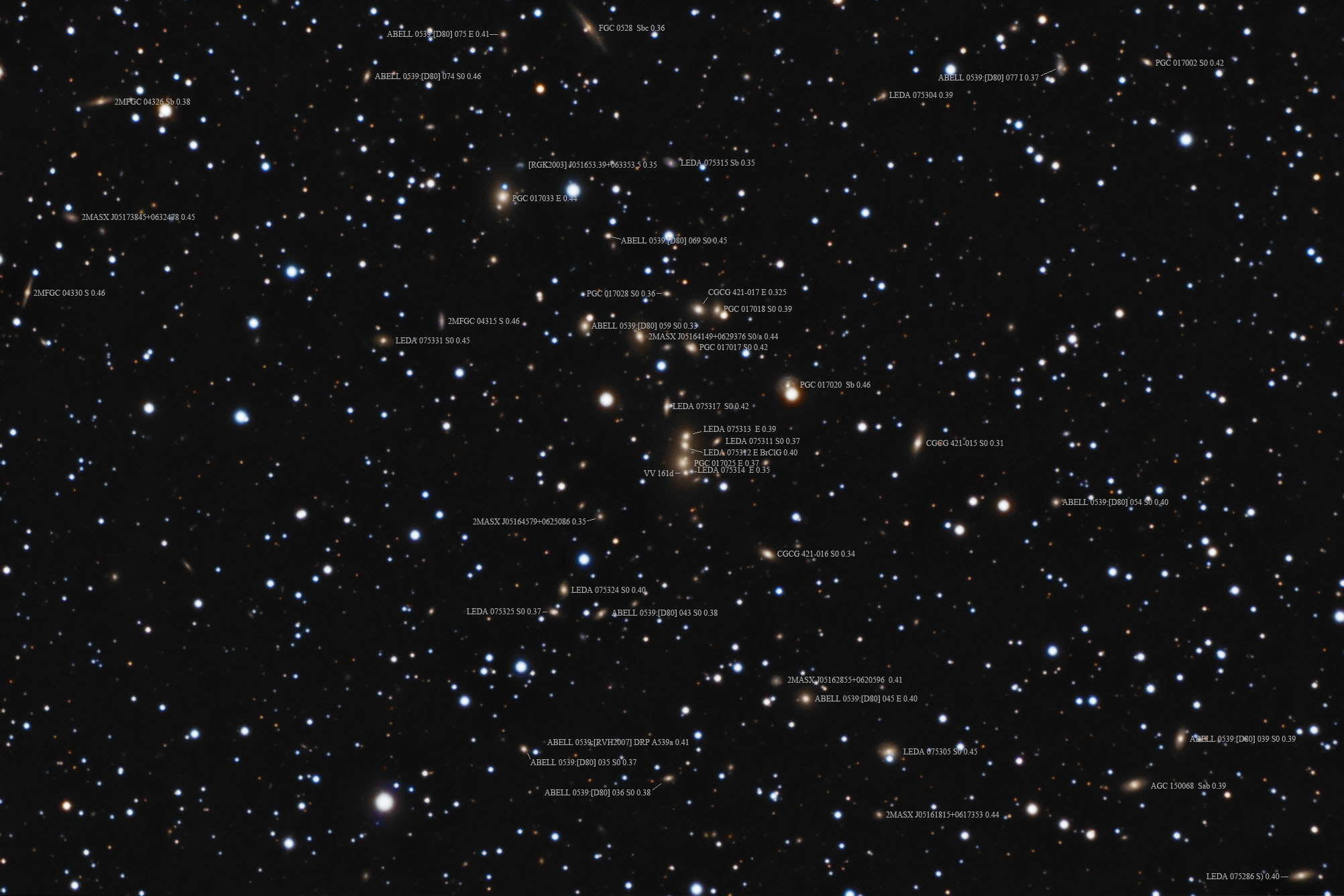
PGC75312L4X10RGB2X10R1ID.JPG
| 
















